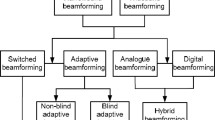Abstract
In this paper, the performances of massive multiuser multiple input multiple output (MMU MIMO) system with different transmit beamforming (BF) techniques and different suboptimal transmit antenna selection (TAS) algorithms over Rayleigh fading channels are investigated. Three linear transmit BF types are considered, namely, maximum ratio transmission (MRT BF), zero forcing (ZF BF) and minimum mean square error (MMSE BF). Two TAS algorithms are considered, that are pairwise error probability minimization (PM) and the capacity maximization (CM). TAS techniques are used in order to reduce the number of radio frequency (RF) chains, system complexity, and cost. This makes MMU MIMO more applicable in beyond 4G communication systems. The simulation results show that TAS algorithms are capable of decreasing the complexity of the system while maintaining the same performance of the MMU MIMO system, complex TAS techniques are not needed at large number of RF chains, and the performance improvement due to the increase of this number is limited to a certain threshold. It also demonstrated that the MMSE BF and ZF BF bit error rate performance values are better than MRT BF values for both CM and PM TAS algorithms, but it is limited to the large number of users. On the other hand, the MRT BF technique performance is good at small Eb/N0 values for both PM and CM TAS but it is relatively less affected by increasing the number of users.







Similar content being viewed by others
References
Chiurtu, N., Rimoldi, B., & Telatar, B. (2001). On the capacity of multi-antenna Gaussian channels. Proceedings 2001 IEEE International Symposium on Inf. Theory, p. 53.
Foschini, G. J., & Gans, M. J. (1998). On limits of wireless communications in a fading environment when using multiple antennas. Wireless Personal Communications, 6, 311–335.
Rusek, F., Persson, D., Lau, B. K., Larsson, E. G., Marzetta, T. L., Edfors, O., et al. (2013). Scaling up MIMO: Opportunities and challenges with very large arrays. IEEE Signal Processing Magazine, 30(1), 40–60.
Marzetta, T. L. (2010). Noncooperative cellular wireless with unlimited numbers of base station antennas. IEEE Transactions on Wireless Communications, 9(11), 3590–3600.
Lu, L., Li, G., Swindlehurst, A. L., Ashikhmin, A., & Zhang, R. (2014). An overview of massive MIMO: Benefits and challenges. IEEE Journal of Selected Topics in Signal Processing, 8(5), 742–758.
Larsson, E. G., Edfors, O., Tufvesson, F., & Marzetta, T. L. (2014). Massive MIMO for next generation wireless systems. IEEE Communications Magazine, 52(2), 186–195.
Jiang, M., & Hanzo, L. (2007). Multiuser MIMO-OFDM for next-generation wireless systems. Proceedings of the IEEE, 95(7), 1430–1469.
Choi, R. L. U., Ivrlač, M. T., Murch, R. D., & Utschick, W. (2004). On strategies of multiuser MIMO transmit signal processing. IEEE Transactions on Wireless Communications, 3(6), 1936–1941.
Joham, M., Utschick, W., & Nossek, J. A. (2005). Linear transmit processing in MIMO communications systems. IEEE Transactions on Signal Processing, 53(8), 2700–2712.
Xiang, Z., Tao, M., & Wang, X. (2014). Massive MIMO multicasting in noncooperative cellular networks. IEEE Journal on Selected Areas in Communications, 32(6), 1180–1193.
Hoydis, J., Ten Brink, S., & Debbah, M. (2013). Massive MIMO in the UL/DL of cellular networks: How many antennas do we need? IEEE Journal on Selected Areas in Communications, 31, 160–171.
Zhao, L., Zhao, H., Hu, F., Zheng, K., & Zhang, J. (2013). Energy efficient power allocation algorithm for downlink massive MIMO with MRT precoding. In 78th IEEE Vehicular Technology Conference, pp. 1–5.
Yoo, T., & Goldsmith, A. (2006). On the optimality of multiantenna broadcast scheduling using zero-forcing beamforming. IEEE Journal on Selected Areas in Communications, 24(3), 528–541.
Sanayei, S., & Nosratinia, A. (2004). Antenna selection in MIMO systems. IEEE Communications Magazine, 42(10), 68–73.
Dao, N. D., & Sun, Y. (2010). User-selection algorithms for multiuser precoding. IEEE Transactions on Vehicular Technology, 59, 3617–3622.
Ko, K., & Lee, J. (2012). Multiuser MIMO user selection based on chordal distance. IEEE Transactions on Communications, 60(3), 649–654.
Yılmaz, A., & Kucur, O. (2014). Performances of transmit antenna selection, receive antenna selection, and maximal-ratio-combining-based hybrid techniques in the presence of feedback errors. IEEE Transactions on Vehicular Technology, 63(4), 1976–1982.
Sklar, B. (1993). Rayleigh fading channels in mobile digital communication systems part I: Characterization. IEEE Communications Magazine, 35(7), 90–100.
Bjornson, E., Bengtsson, M., & Ottersten, B. (2014). Optimal multiuser transmit beamforming: A difficult problem with a simple solution structure [Lecture Notes]. IEEE Signal Processing Magazine, 31(4), 142–148.
El-khamy, S. E., Moussa, K. H., & El-sherif, A. A. (2015). Performance analysis of massive MIMO multiuser transmit beamforming techniques over generalized spatial channel model. In 32nd National Radio Science Conference (NRSC), pp. 139–146.
Gao, X., Edfors, O., Rusek, F., & Tufvesson, F. (2011). Linear pre-coding performance in measured very-large MIMO channels. IEEE Vehicular Technology Conference.
Cho, Y. S., Kim, J., Yang, W. Y. & Kang, C. G. (2010). MIMO-OFDM Wireless Communications with MATLAB.
Author information
Authors and Affiliations
Corresponding author
Rights and permissions
About this article
Cite this article
El-Khamy, S.E., Moussa, K.H. & El-Sherif, A.A. Performance of Enhanced Massive Multiuser MIMO Systems Using Transmit Beamforming and Transmit Antenna Selection Techniques. Wireless Pers Commun 94, 1825–1838 (2017). https://doi.org/10.1007/s11277-016-3713-y
Published:
Issue Date:
DOI: https://doi.org/10.1007/s11277-016-3713-y




